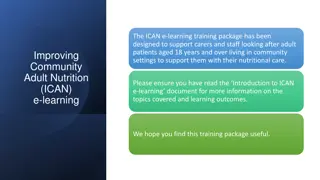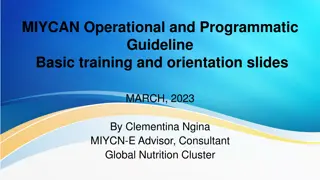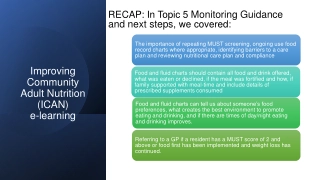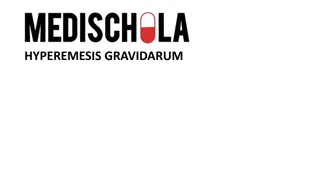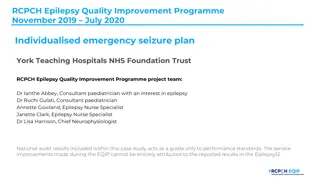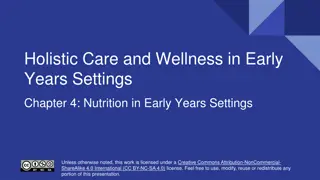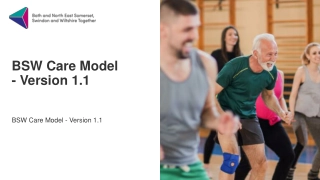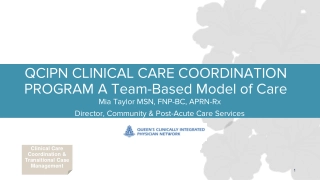Strategies for Managing Malnutrition with Nutritional Care Plans
Understanding how to create and implement a nutritional care plan based on the MUST score, including strategies like Food First and Fortification, can help manage malnutrition effectively. This involves utilizing nutrient-dense foods, promoting wound healing, increasing muscle strength, and improving overall health outcomes.
Download Presentation
Please find below an Image/Link to download the presentation.
The content on the website is provided AS IS for your information and personal use only. It may not be sold, licensed, or shared on other websites without obtaining consent from the author. Download presentation by click this link. If you encounter any issues during the download, it is possible that the publisher has removed the file from their server.
Presentation Transcript
RECAP: In Topic 3 How to create a nutritional care plan we covered: How to create and implement a nutritional care plan based on overall MUST score. Improving Community Adult Nutrition (ICAN) e-learning Health care professionals should always use their professional judgement. Consider patient s overall health status, whether suggested care plan is appropriate and is in line with their overall medical management plan. If unsure always check with key health professionals involved in the patient s care. Always ensure that the nutritional care plan is in line with the nutritional aim.
Leicestershire Nutrition & Dietetic Service ICAN - Treatment and Prevention of Malnutrition Please DO NOT save or share this PowerPoint to avoid circulation of out of date information
Aims: To be familiar with strategies used to manage and treat malnutrition in line with MUST management plans (covered in PowerPoint 3). To understand a systematic approach beginning with a food first strategy, followed by food fortification ideas and thereafter consideration of oral nutritional supplements. To be aware that treating malnutrition also includes ensuring a nutrient dense diet, adequate fluid intake as well as a suitable environment to optimise oral intake and support health and wellbeing.
What is Food First & Fortification When someone has a poor appetite and is malnourished, nutrient dense foods and drinks containing nutrition can help to improve energy intake without making portions too big to manage. Protein, energy (calories) and vitamins and minerals are all important for people who are malnourished to ensure they are getting a nutrient-dense diet. Food First: This is utilising everyday foods which the patient enjoys and offering them more frequently throughout the day to maximise oral intake. Food fortification: Fortifying is when small quantities of everyday foods, such as cheese, milk powder, yoghurt, butter are added to a food or meal to increase the nutritional content, without increasing the portion size. This means every mouthful you eat will be more nourishing.
Provides extra protein, energy and nutrients to: - Promote wound healing - Increase muscle strength - Improve mobility - Reduce risk of infections - Promote weight gain towards a healthy BMI range Benefits of food first and fortification
Food First: General Tips for increasing food intake Smaller meals but more frequently throughout the day Ensure the environment where meals are eaten is calm and peaceful Nourishing snacks and drinks between meals Make foods look attractive - garnish food with parsley, lemon or tomatoes Sharp tasting foods are refreshing. Try fresh fruit, fruit juices, lemon squash or boiled sweets An alcoholic drink if permitted by the doctor, before a meal can help to stimulate appetite
Food First: snack, meal and drink ideas Drinks Lassi Milky tea/coffee/hot chocolate/ ovaltine/horlicks Snacks Dairy based puddings e.g. thick and creamy yogurts/ice cream/custard Sausage roll/pork pie/scotch egg/bhaji Fresh fruit juice/smoothies Creamy soups Crisps Higher calorie biscuits e.g. chocolate coated/cream filled biscuits Light meals Chocolate and sweets Toast with tinned fish/baked beans/ cheese/egg/hummus/butter/marmalade Slice of cake or cheesecake, chocolate mini roll, malt loaf with butter, scone with jam and cream, cheese, muffins Jacket potato with cheese/beans/tuna and mayo/coleslaw/butter/chilli con carne Please click here to access our diet sheet Eating with a small appetite for more ideas Quiche/omelette/fish fingers/macaroni cheese/cauliflower cheese/corned beef hash
Food Fortification Handy essentials to have available: Dried milk powder Cheese Full fat Yogurt Nut butters Cream cheese Butter Full fat margarine Double cream Sugar Honey Jam/marmalade Syrups Oils (olive, vegetable, nuts)
How to use handy essentials to fortify meals: A bowl of porridge 40g porridge + 2 tbsp double cream + 2 tbsp skimmed milk powder (additionally add +1 tbsp honey to increase calories and flavour) 1 scoop of mash potato made with milk + 2 tsps butter *additionally + 25g grated cheddar cheese (if appropriate for patient) and/or 2 tbsp cream A bowl of tomato soup (150ml) + 2 tbsp double cream/2 tsp or butter Home Made milk shake: 140ml of full fat milk, 1tbsp dried milk powder, handful of fruit, 1 scoop ice cream or 1-2 tbsp cream. Added sauce i.e 1 tbsp strawberry, chocolate, honey or ground nuts Rice pudding: 2 tbsp of double cream, generous portion of jam
Nourishing fluids Fluids are important for maintaining optimum bodily function and preventing ill health Although fluids can be filling which can impact on appetite, they can also provide an opportunity to improve nutritional status when oral intake of foods is minimal e.g. offering nourishing smoothie/pure fruit juice instead of squash Milkshakes, fruit juices, smoothies and soups can be high in energy, protein, vitamins and minerals Click here for nourishing drinks recipes Further detailed information on general hydration guidance is covered in PowerPoint 6
Alternative food fortification considerations Vegan: houmous, avocado, vegetable oil, ground nuts, dairy free products i.e. soya cream, coconut yogurts and ice cream, homemade milkshake with full fat tin of coconut milk as base Dairy free diet: soya or other dairy free milks/yogurts fortified with calcium, milk free spreads, honey, jam Cardio-protective: olive oil, vegetable oil spreads to replace butter/cream, ground nuts Diabetes: milk powder, cheese, cream, butter, fats and oils (avoid adding extra sugar and sweet foods) Standard food fortification ideas previously mentioned may not be suitable for your resident if they have allergies or restrict their diet for cultural or other health reasons, these ideas could be used instead
Other considerations: Texture modified diet and fluids Always follow speech and language therapists (SLT) recommendations in line with IDDSI considerations (covered in PowerPoint 6) Cultural Always ensure food fortification considers cultural preferences Allergens/ Intolerances Always ensure these are clearly documented and followed when fortifying foods
TIPS TO ENSURE A GOOD DINING ENVIRONMENT: These adaptations can be supportive for those with visual impairments, cognitive decline e.g., dementia/post stroke or when generally unwell and appetite is reduced Adequate lighting- appropriate lighting can help in seeing and recognizing foods offered, making it much easier to eat Serve meals and snacks at the same times each day- consistency helps establish a routine and this may help improve intake Eat meals with others- keep the patient centred; this could be in a large dining area with others or eating in a quiet environment with 1-2 others that the individual feels comfortable Minimise distractions Please see Dementia UK Eating and Drinking guide Ensure appropriate food options are readily available if patients miss a meal or snack if they have been asleep or away at mealtimes Make food the focus
Come in a variety of forms that provide additional energy, protein, vitamins and minerals. e.g. powdered, pre mixed milkshake, juice style, desserts style, small volume, modified thickness. Dietitian chooses most appropriate supplement dependent on the patient s need. Oral Nutritional Supplements (ONS)
Key considerations when using ONS ONS should only be prescribed when: First-line dietary advice has not been sufficient alone Flavour fatigue can affect compliance, therefore flavours should be varied Supplements should be taken after or between meals They should not be used on a long term basis without regular monitoring and re-assessment ONS can be offered chilled or warm, however if specific IDDSI fluid levels in place by SLT then this may alter the thickness of fluids and therefore may not be appropriate Prescribing of ONS are based on addressing specific dietary needs following individual patient s dietetic assessment therefore they should ONLY be given to that individual Remember: even if a patient is taking supplements, food first is still of benefit and should be continued. Supplements do not replace food.
Knowledge Check: Ethel is still feeling poorly following her chest infection and still eating less than her meals and losing weight. Consider how you could fortify her current diet. Also think about what other factors are important to optimise oral intake ?
Breakfast: Lunch/Evening meal: Soup: Add butter/cream/cheese Chicken Pie: Add extra cream and cheese to filling Mash potato: Add butter, cream, cheese Veg: Add melted butter when serving Cereal: Use enriched milk/add 1-2 tablespoons double cream/ jam/honey Toast: Add extra thick spread of butter/encourage other toppings jam/honey/marmalade/chocolate spread Food fortification ideas to encourage/offer Ethel Snacks/Pudding: Can we offer some custard/full fat yoghurt alongside fruitcake? Would Ethel like some cheese and crackers instead of plain biscuits? Fluids: Tea: Ensure full fat milk used, add extra milk, sugar Hot chocolate: add cream, marshmallows, full fat milk Offer variety of fluids- considerfresh juice/home made milkshakes/smoothies as an alternative? Environment: Consider if Ethel eats better with others? Is there adequate lighting? Are there any distractions? Is the temperature of the food appropriate ?
Summary Food first and food fortification strategies help to provide extra protein to promote wound healing, increase muscle strength, improve mobility, reduce risk of infections. They also help to provide extra energy (calories) to promote weight gain and helps the body to use protein effectively. Although fluids can be filling which can impact on appetite, they can also provide an opportunity to improve nutritional status when oral intake of foods is minimal. ONS should only be prescribed when first-line dietary advice has not been sufficient alone. They should not be used on a long term basis without regular monitoring and re-assessment. Always be mindful of the suitability of foods used to enrich a patient s diet if they - are on a texture or fluid modified diet - have specific cultural or dietary preferences - have allergies/intolerances which may require special considerations. Treating malnutrition also includes ensuring a nutrient dense diet, adequate fluid intake as well as a suitable environment to optimise oral intake and support health and wellbeing.



